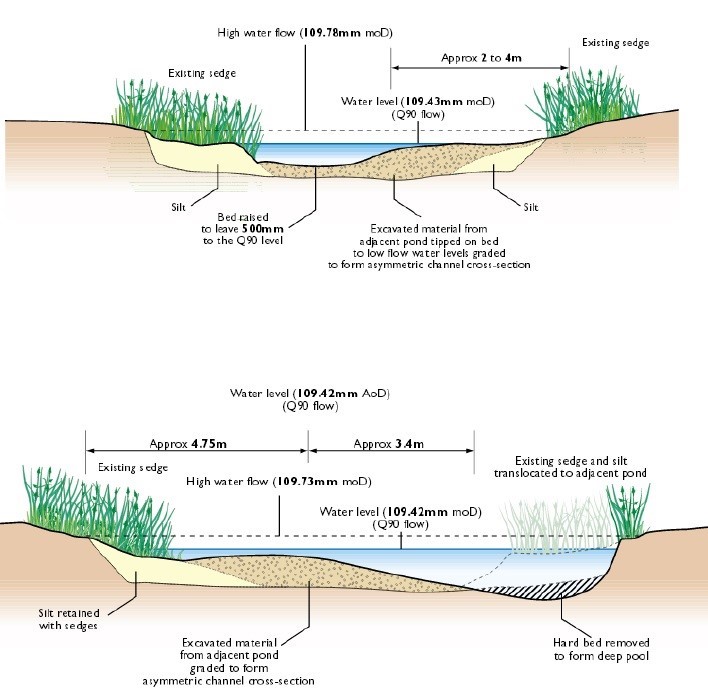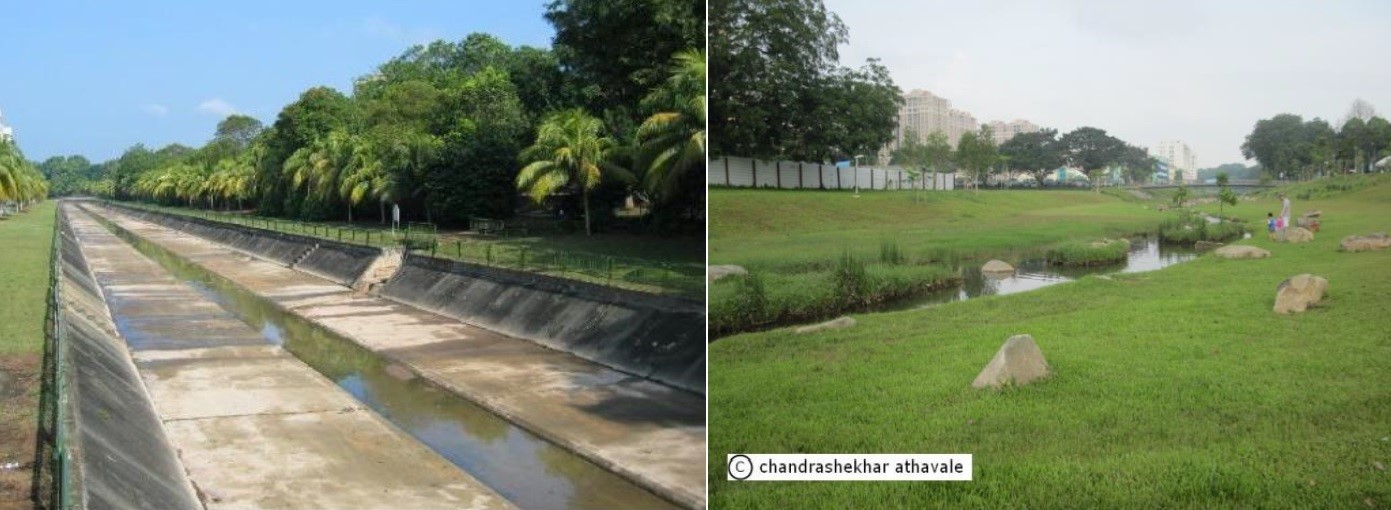Riverbed material restoration and re-naturalization
Riverbed material restoration
Riverbed material represents the sediment eroded upstream, transported by the river and deposited on the river floor. It can be composed of coarse and/or fine material. Its renaturalization consists in recovering the nature-like structure and composition of the bed load, in particular the equilibrium between coarse and fine sediment. In case of deficit of coarse sediment leading to river incision, the main objective is to level-up the riverbed with this type of sediment, by reactivating bank erosion in terrains contributing to this type of sediment. It should be noticed that in case of excess of fine sediment causing inundations, silting of hydro-electric dams or degradation of fish habitats, the main objective is to control erosion on slopes and riverbanks providing this type of sediment.

Source: http://www.therrc.co.uk/pdf/manual/MAN_5_5.pdf
Impacts:
- Store Runoff → Medium (By slowing down runoff, the latter will be increasingly stored)
- Slow Runoff → Medium (Runoff will be slowed down during flood events, due to a better connectivity with the floodplain)
- Store River Water → Medium (By allowing a better connection to tributaries and restoring a natural shape to the river bed, its storage capacity is increased.)
- Slow River Water → Medium (Slower drainage due to reconnection with the functional floodplain)
- Reduce erosion and/or sediment delivery → Low (In case of deficit of coarse sediment leading to river incision, the main objective is to level-up the riverbed with this type of sediment, by reactivating bank erosion in terrains contributing to this type of sediment, thus decrease in alluvial mattress erosion. But in case of excess of fine sediment causing inundations, silting of hydro-electric dams or degradation of fish habitats, the main objective is to control erosion on slopes and riverbanks providing this type of sediment)
Capital and maintenance costs:
- Capex → n/a
- Maintenance → n/a
Stream bed re-naturalization
Streambed (or riverbed) represents the floor of the river, including each riverbank. In the past, riverbeds were artificially reconstructed with concrete or big stones, therefore modifying flows and decreasing fauna habitat and vegetation diversity. Those modifications were aiming at flood prevention or supporting changes of agricultural practices for example. This has led to uniformed flows in the rivers and often having effect of reducing travel time along the river. Streambed renaturalization consists in removing some concrete or inert constructions in the riverbed and on riverbanks, then replacing them with vegetation structures, in order to avoid these damages and restore biodiversity. The re-naturalization of river beds and banks could have a high impact on the erosion process.

Source: http://chandrashekharasandprints.wordpress.com/2012/05/11/restoring-an-urbanriver-bed-to-its-natural-eco-system-a-singapore-experiment/
Impacts:
- Store River Water → Medium (By diversifying the channel width and depth, this measure can increase the water storage capacity of the river.)
- Slow River Water → High (By diversifying the river bed morphology and increasing its roughness, especially with vegetation, this measure helps slowing down the river flow.)
- Increase evapotranspiration → Low (Any replacement of concrete structure by vegetation structure will allow increasing evapotranspiration)
- Increase infiltration and/or groundwater recharge → High (The re-naturalization of the river bed restores the connectivity between the stream and the accompanying groundwater, therefore increasing stream-subsurface water exchanges.)
- Increase soil water retention → Low (Any replacement of concrete structure by vegetation structure will allow increasing soil water retention)
- Reduce erosion and/or sediment delivery → High (These techniques allow protecting the riverbed and the riverbanks against erosion, by improving their roughness, cohesiveness and biodiversity.)
- Improve Soils → Medium (These techniques allow the development and improvement of soil, due to the increasing presence and growth of vegetation.)
- Reduce peak temperature → Medium (Riparian vegetation (trees) could provide shadow for the river, reducing the peak temperature especially during the summer season while base flows occur.)
- Absorb and/or retain CO2 → Low (Any replacement of concrete structure by vegetation structure will allow absorbing and/or retaining CO2.)
Capital and maintenance costs:
- Capex → Assess general costs would have no sense because they fully depend of the local context.
- Maintenance → n/a
Source: European Natural Water Retention Measures Platform, 2015 (http://nwrm.eu/measure/riverbed-material-renaturalization; European Natural Water Retention Measures Platform, 2015 (http://nwrm.eu/measure/stream-bed-re-naturalization)


